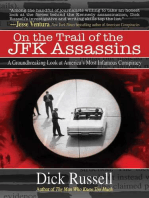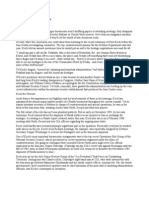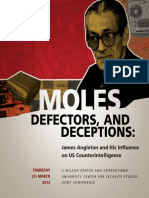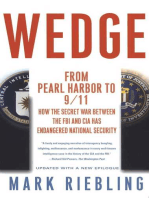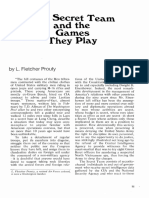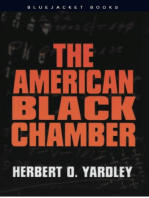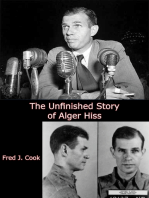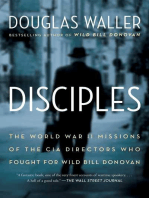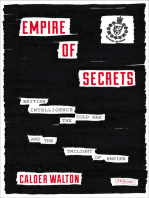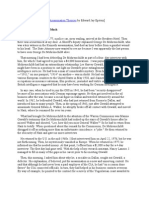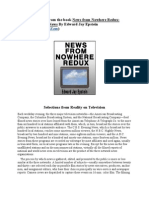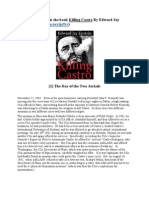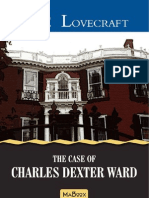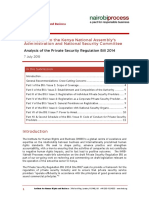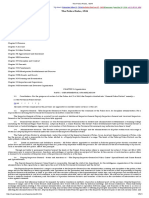Professional Documents
Culture Documents
James Jesus Angleton: Was He Right by Edward Jay Epstein
Uploaded by
edepsteinOriginal Description:
Copyright
Available Formats
Share this document
Did you find this document useful?
Is this content inappropriate?
Report this DocumentCopyright:
Available Formats
James Jesus Angleton: Was He Right by Edward Jay Epstein
Uploaded by
edepsteinCopyright:
Available Formats
This is an excerpt from the book, James Jesus Angleton: Was He Right? (http://amzn.
to/qIA9VT) By Edward Jay Epstein
__________________________________________________________________
PROLOGUE
THE FUNERAL OF A MIND WARRIOR
____________________________________________________________________ On May 14, 1987, some of the most powerful men in Washington, including senators, ambassadors, cabinet officers, generals, and two former directors of Central intelligence, gathered in a small church in Arlington, Virginia to pay their last respects to James Jesus Angleton. The only decoration was a wreath of giant purple orchids, sent by Angletons former comrades in the OSS, the organization where forty-four years earlier he had begun his career as a spy. Few words were spoken, nor needed to be. The poem Gerontion, written by his friend T. S. Eliot, perfectly described his quest. It describes a blind mans journey through a wilderness of mirrors," a journey very much like Angletons effort to find his way through the labyrinth of deception in the Cold War. The service for the poet-spy was over in less than forty minutes. Most of those attending the service were familiar with Angletons extraordinary career. He was born on December 9,1917 in Boise, Idaho, the same year as the Russian Revolution. His father, James Hugh Angleton, had been a cavalry officer in the Idaho national guard who had
met his mother, Carmen Mercedes Moreno, on a military expedition to Mexico. She was only seventeen year old when they married. She gave her son a common Mexican middle name, Jesus. Fifteen years later, his father bought the Italian franchise for the National Cash Register Company, and moved his family to Milan Italy. Angleton then went to Malvern College in England before going to Yale in 1937. There, together with his roommate Reed Whittemore, he founded and edited Furioso, a quarterly devoted to original poetry. Through it, he published such leading poets as Ezra Pound, Archibald MacLeish, and e.e cummings. He graduated with high honors in 1941 and married Cicely dAutremont. He briefly went to Harvard Law School, but never graduated. Instead he joined the U.S. Army, enrolling, along with his father, in the Office of Strategic Services (OSS), Americas newly formed intelligence service. He was first stationed in London and then Rome. When the OSS was dissolved in 1945, Angleton was assigned to a secret intelligence unit, called the "Central Intelligence Group," which became the CIA in 1947. Re-assigned to its Washington headquarters in 1949, he acted as the CIA liaison with the British, French, Italian, and West German intelligence services. Then in 1954, he was made the chief of the newly-created Counterintelligence Staff, a position which he held until Christmas Eve of 1975 when he retired from the CIA. After his death, his actual achievements were eclipsed by his legend. In the media, he was transmogrified into the CIAs version of a Captain Ahab wreaking destruction of all around him by his pursuit of his own phantasmagorical great white whale. Books on the CIA depicted him as a paranoid mole hunter obsessively searching for non-existing spies planted in the heart of the CIA and non-existing deception plots aimed at the American government. His legend also became the stuff of fiction. He was the basis for a deranged and paranoid spy hunter in everything from movies, such as The Good Shepherd (where he is played by Matt Damon) and TV mini-series, such as The Company (where he is played by Michael Keaton) to novels, such as Norman Mailers Harlots Ghost. Like many legends, his portrayal had some basis in reality. It is true that he had deep-seated suspicions about KGB operations that could be construed as paranoia. It is also true that he conducted a 20 year long mole hunt, that he believed both the CIA and FBI were vulnerable to Soviet penetration at the highest level, and that the KGB passed disinformation through intelligence channels to the White House. Even though these contentions of a state-sponsored conspiracy to manipulate Presidents of the United States made him the object of ridicule in the media, the question remains: Was Angleton right? _____________________________________________________________ PART ONE DOWN THE RABBIT HOLE ______________________________________________________________ [1] Flowers of Deception I first met James Jesus Angleton in February 1976. At that time, I knew nothing about his secret world of deception. Nor had I even heard of the concepts of "disinformation", "dangles" "false flags" or "penetrations," which were central elements in it. I had just begun a book on Lee Harvey Oswald, the alleged assassin of President John F.
Kennedy. Although Oswald was investigated by the Warren Commission, the FBI, and other intelligence services, there was still a missing piece in the jigsaw puzzle the nearly two years that he had spent in the Soviet Union before he returned to the United States in 1962. What had happened to Oswald during this period? Had he had connections with Soviet intelligence during this Russian period? Had the KGB sponsored his return to the US? Had he been given any mission in America? I had now been offered an opportunity to exclusively interview a man who supposedly could provide definitive answers to all these questions Yuri Nosenko. He was the KGB officer who had not only superintended Oswald's handling in Moscow in 1959 but had also reviewed his entire file KGB after the assassination. He then defected to the CIA. Not even the Warren Commission had been allowed to interview him. Now Donald Jamison, who was handling Nosenko on behalf of the CIA, was making him available for a book I was writing for the Readers Digest Press. Nosenko is utterly reliable on the subject of Oswald, Jamison assured me, He had full access to his KGB records. How could I refuse such an offer? I had begun my interviews with Nosenko in January 1976. After I had completed six hours of interviews with Nosenko, I found several of the assertions he made about the KGB's treatment of Oswald inconsistent with other evidence furnished the Warren Commission. Even though I was assured by his CIA handler that he was utterly reliable on the subject, and had full access to KGB records, as he claimed, I was not completely satisfied. His insistence that the KGB had never contacted Oswald during his stay in the Soviet Union seemed implausible since Oswald had loudly advertised on his arrival that he had some secret information of special interest to the Soviet Union. My doubts were not entirely alleviated. I had lunch later that week with a Soviet diplomat in Washington, Igor Agou, to facilitate getting a visa to go to Russia. When I told Agou that I wanted to interview a number of Russian citizens who had been acquaintances of Oswald, he replied, "there is no need for you to go to Russia. He then, lowering his voice to a whisper, added, the best source on Oswald's visit there is in America. He is Yuri Nosenko." I found it curious that the Soviet Embassy would recommend that I see a Soviet traitor: indeed, the same traitor the CIA had also recommended to me. Disquieted by this coincidence, I went back to see Jamison. I pressed him about why, if Nosenko was such a valuable source, the Warren Commission had not called him as a witness in 1964. After all, the Commission noted in its report that it lacked access to the Soviet files on Oswald. According to both Jamison and Agou, Nosenko could have filled that gap. He answered that there had been some "minor problem" with Nosenko at that time. They were technicalities about his defection that had now been cleared up. When I asked further about the problem, he said that it was "too sensitive" to be discussed. He closed the issue by saying "In any case, it is not relevant to your book. Dont worry about it further." But I did. I began looking for an ex-CIA officer who would know about the problem with Nosenko in 1964. In 1975, the investigative reporter Seymour Hersh had published a story in the New York Times reporting an illegal CIA counterintelligence activity that resulted in the firing of a number of CIA executives. The most prominent among them was James Jesus Angleton, who, on checking his name, I found that he had also been a liaison with the Warren Commission. Making contact with Angleton was not difficult; he was listed in the Virginia telephone directory. When told him on the phone that I had interviewed Nosenko, he said I wouldnt have thought they would be letting him out so soon but I would be very interested in what he has to
say. He agreed to meet me for dinner at the Madison Hotel, which he chose because it had a secure garage. He arrived in a black homburg, looking like someone that Central Casting might have chosen for the part of a counterintelligence chief. He was ghostly-thin, with deep-set eyes accentuated by arched eyebrows. He had an enigmatic smile, and a finely-sculptured face which, I later learned, had been proposed half-facetiously as an appropriate logo for the CIA. He lit a cigarette as we sat down at the table and coughed. He explained that he suffered from emphysema and ulcers. A quarter of a century in counterintelligence had evidently exacted some toll. Since Angleton's counterintelligence staff had the responsibility for evaluating information supplied by KGB defectors, I assumed that he would be in a position to clarify what Nosenko had been telling me about Oswald and the KGB. I had no idea then that Nosenko had been the subject of a bitter ten-year battle inside the CIA that had been buried, along with a halfdozen careers, but not settled. I merely want to know why the Warren Commission had not called Nosenko. So I asked him "Was there any problem with Nosenko's veracity?". Angleton answered, with a thin smile, suggesting a deliberate understatement, "There are always problems when it comes to defectors." He explained that his job was establishing the bona fides of defectors. And that was not always possible. Did you award Nosenko his bona fides? I asked. He replied that he could not discuss individual cases, and with that, he abruptly cut off the conversation about Nosenko, and effortlessly moved on to another subject of which I had no understanding at all: orchids. There are over ten thousand identified species of orchids divided into tribes, I heard him say. He was describing orchid tribes, growing at different levels of a rain forest, with such exotic names as Dendrobian, Phalaenopsis, Cattleya, Cymbidian, and Brassia. He then invited me to accompany him to an orchid supplier called Kensington Orchids in Maryland I met him there the following week. He talked as we walked through the steamy greenhouse as if he were conducting a lecture tour. What fascinated him about these orchids were their deceptive qualities. As he explained it, it has not been the fittest but the most deceptive orchid that has survived. The perpetuation of most species of orchids depends on their ability to misrepresent themselves to insects. Having no food to offer the insects, they had to deceive them into landing on them and carrying their pollen to another orchid in the tribe. Orchids are too dispersed in nature to depend on the wind to carry their pollen. To accomplish this deception, orchids use color, shape and odor to mimic something that attracts insects to their pods of pollen. Some orchids play on the sexual instincts of insects. The Trichoceros orchid, for example, so perfectly mimics in three-dimensions the underside of a female fly, down to the hairs and smell, that it triggers mating response from passing male flies. Seeing what he thinks is a female fly, the male fly swoops down on the orchid, and attempts to have sex with it-- a process called pseudo-copulation. The motion causes the fly to hit the pollen pod, which attaches itself to his underside. The fly thus becomes an unwitting carrier. When it then passes another trichoceros orchid, and repeats the frustrating process, it pollinates that orchid. Other orchids play on the survival instinct of insects. Some oncidium orchids have an almost exact replica of a bee's head on their petals. When a passing wasps sees this image of danger lurking behind it, its survival mechanism is triggered. The wasp plunges its stinger
through its illusionary foe. The stinger passes through the petal into the pollen pod, which then adheres to it. When the wasp sees another Oncidium orchid, which provokes the same response, it pollinates the orchid. Angleton called this process of provocation, "pseudo-attack". In yet another twist on this theme, orchids lure insects to them by emitting odors that exactly mimic those of nectar and other food sources. This smell lures the insect into the orchid's maze-like structure where instead of finding the nectar it runs into the pollen. This deception is especially effective against the mosquito who, while looking for nectar in a narrow tunnel, gets the pollen pod jammed into its eye. Unable to see, it flies away, until it smells a similar nectar. The blind mosquito this time delivers the pollen. He explained that such deceptions work because identifications in nature are often hastily keyed to a single signal, without insects having the ability to assess whether the object itself is real or fake. By this time, it became clear that he was not only talking about an insect being manipulated through deception but an intelligence service being similarly duped, seduced, provoked, blinded, lured down false trails and used by an enemy. Finally, at a long leisurely lunch in Georgetown, I returned to the subject of Nosenko. Was Angleton suggesting that a KGB defector like Nosenko could have mimicked a real defector to attract the CIA to misleading information. He answered "Soviet intelligence certainly has that capacity". "The capacity to send out false defectors?" "You know about The Trust"? I shook my head, I had not heard of The Trust before. "Is it t connected to the Nosenko case? He answered " If you want to understand Soviet deception, you have to go back to The Trust. Otherwise, you'll just waste my time. Talk to the Rock. He'll tell you all about it. This chapter is excerpted from Edward Jay Epsteins book James Jesus Angleton: Was He Right?, now available on Kindle (http://amzn.to/qIA9VT) and Kindle apps for ipad. It is also available on Nook (http://bit.ly/n4cozI) and the itunes Store. Other books by Edward Jay Epstein can be found at: (http://amzn.to/ndfiNf)
James Jesus Angleton: Was He Right? By Edward Jay Epstein Other Books By Edward Jay Epstein
Inquest Legend News From Nowhere The Rise and Fall of Diamonds Agency of Fear Between Fact and Fiction The Assassination Chronicles The Big Picture The Hollywood Economist Myths of the Media EJE Originals The Money Demons James Jesus Angleton: Was He Right? Armand Hammer: The Darker Side The Rockefellers The JFK Assassination Theories Garrisons Game Zias Crash Who Killed Gods Banker The Crude Cartel Killing Castro Tabloid America: Crimes of the Press Copyright by EJE Publication 2011 All Rights Reserved ISBN 978-1-61704-079-5 Cover Design By Jennifer Kim
For Sir James Goldsmith About The Author Edward Jay Epstein studied government at Cornell and Harvard, receiving his Ph.D. from Harvard in 1973. His master's thesis at Cornell was published as Inquest: The Warren Commission and the Establishment of Truth and became a national best seller; his doctoral dissertation at Harvard was published as News From Nowhere: The Selection of Reality on Television, and is today a standard textbook in media studies courses . He taught political science at MIT and UCLA before becoming a full time author. He lives in New York City. His
website is www.edwardjayepstein.com
You might also like
- State Secret: PrefaceDocument47 pagesState Secret: PrefacebsimpichNo ratings yet
- On the Trail of the JFK Assassins: A Groundbreaking Look at America's Most Infamous ConspiracyFrom EverandOn the Trail of the JFK Assassins: A Groundbreaking Look at America's Most Infamous ConspiracyRating: 4 out of 5 stars4/5 (6)
- The Very Best Men: The Daring Early Years of the CIAFrom EverandThe Very Best Men: The Daring Early Years of the CIARating: 2.5 out of 5 stars2.5/5 (2)
- Top Secret Papers Reveal Oswald Was CIA Agent: POWERS and His Attorney HoldDocument4 pagesTop Secret Papers Reveal Oswald Was CIA Agent: POWERS and His Attorney HoldVincentNo ratings yet
- The Venona Secrets: Exposing Soviet Espionage and America's TraitorsFrom EverandThe Venona Secrets: Exposing Soviet Espionage and America's TraitorsRating: 4.5 out of 5 stars4.5/5 (2)
- Coup D'etat in America Volume OneDocument540 pagesCoup D'etat in America Volume OneAlan Jules Weberman100% (3)
- Edward Jay Epstein - Deception. The Invisible War Between The KGB and The CIA (1989)Document317 pagesEdward Jay Epstein - Deception. The Invisible War Between The KGB and The CIA (1989)plan2222No ratings yet
- Scorpions' Dance: The President, the Spymaster, and WatergateFrom EverandScorpions' Dance: The President, the Spymaster, and WatergateNo ratings yet
- Special Operations SamuraiDocument4 pagesSpecial Operations SamuraiJonathan MarshallNo ratings yet
- Sudo PlatovDocument47 pagesSudo PlatovCălin CâmpianuNo ratings yet
- Soviet Intelligence Activities in The United StatesDocument8 pagesSoviet Intelligence Activities in The United StatesNasir KhanNo ratings yet
- American Spy: My Secret History in the CIA, Watergate and BeyondFrom EverandAmerican Spy: My Secret History in the CIA, Watergate and BeyondRating: 2.5 out of 5 stars2.5/5 (3)
- An Inside Look: Watergate and The World of The CIA (1973)Document7 pagesAn Inside Look: Watergate and The World of The CIA (1973)Regular BookshelfNo ratings yet
- Espionage Against PolandDocument24 pagesEspionage Against Polandgladio67No ratings yet
- Parapolitics/USA No.5Document24 pagesParapolitics/USA No.5Jonathan MarshallNo ratings yet
- Oswald and the CIA: The Documented Truth About the Unknown Relationship Between the U.S. Government and the Alleged Killer of JFKFrom EverandOswald and the CIA: The Documented Truth About the Unknown Relationship Between the U.S. Government and the Alleged Killer of JFKRating: 3.5 out of 5 stars3.5/5 (6)
- The Puzzle Palace: A Report on NSA, America's Most Secret AgencyFrom EverandThe Puzzle Palace: A Report on NSA, America's Most Secret AgencyRating: 3.5 out of 5 stars3.5/5 (120)
- Moles, Defectors and Deceptions - James Angleton and His Influence On US Counterintelligence (29.03.2012)Document121 pagesMoles, Defectors and Deceptions - James Angleton and His Influence On US Counterintelligence (29.03.2012)don_ro_2005100% (4)
- Practise to Deceive: Learning Curves of Military Deception PlannersFrom EverandPractise to Deceive: Learning Curves of Military Deception PlannersRating: 5 out of 5 stars5/5 (1)
- The Office of Strategic Services (OSS)Document7 pagesThe Office of Strategic Services (OSS)farooq hayatNo ratings yet
- Burn After Reading: The Espionage History of World War IIFrom EverandBurn After Reading: The Espionage History of World War IIRating: 3.5 out of 5 stars3.5/5 (6)
- Wedge: From Pearl Harbor to 9/11: How the Secret War between the FBI and CIA Has Endangered National SecurityFrom EverandWedge: From Pearl Harbor to 9/11: How the Secret War between the FBI and CIA Has Endangered National SecurityRating: 4.5 out of 5 stars4.5/5 (5)
- The Secret Team and The Games They Play (1970)Document9 pagesThe Secret Team and The Games They Play (1970)Regular BookshelfNo ratings yet
- Romeo SpyDocument247 pagesRomeo SpygichuraNo ratings yet
- Another Herbert O Yardley Mystery - The PondDocument4 pagesAnother Herbert O Yardley Mystery - The PondQuibus_LicetNo ratings yet
- Polka Dot File on the Robert F. Kennedy Killing: The Paris Peace Talks ConnectionFrom EverandPolka Dot File on the Robert F. Kennedy Killing: The Paris Peace Talks ConnectionRating: 5 out of 5 stars5/5 (6)
- Michael V. Hayden’s Playing to the Edge American Intelligence in the Age of Terror | SummaryFrom EverandMichael V. Hayden’s Playing to the Edge American Intelligence in the Age of Terror | SummaryNo ratings yet
- A Certain ArroganceDocument23 pagesA Certain ArroganceAngelSmith8546100% (1)
- Spies and Traitors: Kim Philby, James Angleton and the Friendship and Betrayal that Would Shape MI6, the CIA and the Cold WarFrom EverandSpies and Traitors: Kim Philby, James Angleton and the Friendship and Betrayal that Would Shape MI6, the CIA and the Cold WarNo ratings yet
- S-172: Lee Harvey Oswald Links to Intelligence AgenciesFrom EverandS-172: Lee Harvey Oswald Links to Intelligence AgenciesRating: 4 out of 5 stars4/5 (1)
- Spooks: The Haunting of America—The Private Use of Secret AgentsFrom EverandSpooks: The Haunting of America—The Private Use of Secret AgentsRating: 4 out of 5 stars4/5 (2)
- Terms & Code Words in OSS RecordsDocument8 pagesTerms & Code Words in OSS Recordseliahmeyer100% (1)
- Circle of Treason: A CIA Account of Traitor Aldrich Ames and the Men He BetrayedFrom EverandCircle of Treason: A CIA Account of Traitor Aldrich Ames and the Men He BetrayedRating: 3.5 out of 5 stars3.5/5 (16)
- CIA Rogues and the Killing of the Kennedys: How and Why US Agents Conspired to Assassinate JFK and RFKFrom EverandCIA Rogues and the Killing of the Kennedys: How and Why US Agents Conspired to Assassinate JFK and RFKRating: 4 out of 5 stars4/5 (1)
- The Mossad Inside Stories (Dennis Eisenberg, Uri Dan, Eli Landau) (Z-Library)Document278 pagesThe Mossad Inside Stories (Dennis Eisenberg, Uri Dan, Eli Landau) (Z-Library)Karanja GitauNo ratings yet
- Valentine, Douglas - The French Connection Revisited - The CIA, Irving Brown, and Drug Smuggling As Political Warfare (1999)Document6 pagesValentine, Douglas - The French Connection Revisited - The CIA, Irving Brown, and Drug Smuggling As Political Warfare (1999)Quibus_Licet100% (1)
- Culper Spy RingDocument9 pagesCulper Spy Ringapi-274404034No ratings yet
- Disciples: The World War II Missions of the CIA Directors Who Fought for Wild Bill DonovanFrom EverandDisciples: The World War II Missions of the CIA Directors Who Fought for Wild Bill DonovanRating: 4 out of 5 stars4/5 (9)
- Faustian Bargains: Lyndon Johnson and Mac Wallace in the Robber Baron Culture of TexasFrom EverandFaustian Bargains: Lyndon Johnson and Mac Wallace in the Robber Baron Culture of TexasRating: 3 out of 5 stars3/5 (2)
- Wild Bill Donovan: The Spymaster Who Created the OSS and Modern American EspionageFrom EverandWild Bill Donovan: The Spymaster Who Created the OSS and Modern American EspionageRating: 3.5 out of 5 stars3.5/5 (45)
- The Spy's Son: The True Story of the Highest-Ranking CIA Officer Ever Convicted of Espionage and the Son He Trained to Spy for RussiaFrom EverandThe Spy's Son: The True Story of the Highest-Ranking CIA Officer Ever Convicted of Espionage and the Son He Trained to Spy for RussiaRating: 4 out of 5 stars4/5 (13)
- Dorothy, "An Amoral and Dangerous Woman": The Murder of E. Howard Hunt's Wife Watergate's Darkest SecretFrom EverandDorothy, "An Amoral and Dangerous Woman": The Murder of E. Howard Hunt's Wife Watergate's Darkest SecretRating: 0.5 out of 5 stars0.5/5 (1)
- Empire of Secrets: British Intelligence, the Cold War, and the Twilight of EmpireFrom EverandEmpire of Secrets: British Intelligence, the Cold War, and the Twilight of EmpireRating: 3.5 out of 5 stars3.5/5 (14)
- Vassiliev Notebooks ConcordanceDocument493 pagesVassiliev Notebooks ConcordanceMalion HoxhallariNo ratings yet
- The Man Who Knew Too Much: The JFK Assassination TheoriesDocument4 pagesThe Man Who Knew Too Much: The JFK Assassination TheoriesedepsteinNo ratings yet
- Demonizing Goldman Klone 2 WORDDocument4 pagesDemonizing Goldman Klone 2 WORDedepsteinNo ratings yet
- News From Nowhere Redux: Television and The News by Edward Jay EpsteinDocument6 pagesNews From Nowhere Redux: Television and The News by Edward Jay EpsteinedepsteinNo ratings yet
- Killing Castro by Edward Jay EpsteinDocument4 pagesKilling Castro by Edward Jay EpsteinedepsteinNo ratings yet
- Scribble First ChapterDocument15 pagesScribble First ChapteredepsteinNo ratings yet
- The Milken Revolution and Its ConsequencesDocument15 pagesThe Milken Revolution and Its ConsequencesedepsteinNo ratings yet
- Comparative Police Systems: A Guide to Key DifferencesDocument60 pagesComparative Police Systems: A Guide to Key DifferencesFERNANDO JR MEJINONo ratings yet
- Case ReferralDocument1 pageCase ReferralMalatbalat, O'niel C.No ratings yet
- Election OffensesDocument60 pagesElection OffensesNiño Anthony SilvestreceNo ratings yet
- Playing by The Rules - An Inside Out Guide To Behaving in The Square MileDocument7 pagesPlaying by The Rules - An Inside Out Guide To Behaving in The Square MileLuca SeramisNo ratings yet
- Organizing A Legal DiscussionDocument5 pagesOrganizing A Legal Discussionelan de noirNo ratings yet
- H. P. Lovecraft - The Case of Charles Dexter WardDocument173 pagesH. P. Lovecraft - The Case of Charles Dexter WardMarco BologniniNo ratings yet
- News Writing ExerciseDocument1 pageNews Writing ExerciseAntonio Delgado100% (1)
- PP v. ObreroDocument3 pagesPP v. ObreroCes CamelloNo ratings yet
- Badal - The 2000 action drama starring Bobby DeolDocument2 pagesBadal - The 2000 action drama starring Bobby DeolSPD TIWARINo ratings yet
- 1984 Study Guide - Extra Exam Not UsedDocument2 pages1984 Study Guide - Extra Exam Not UsedShaina Johnston100% (3)
- En BancDocument28 pagesEn BancPrince FaithNo ratings yet
- Fire Code Art8Document3 pagesFire Code Art8patitay036817No ratings yet
- 2015 07 07 Analysis of Kenya Private Security Regulations Bill 2014 PDFDocument13 pages2015 07 07 Analysis of Kenya Private Security Regulations Bill 2014 PDFfelixmuyoveNo ratings yet
- Criminal Law Book 2 Titles 9 OnwardsDocument99 pagesCriminal Law Book 2 Titles 9 Onwardsmickey2003100% (2)
- MC 2019-114 Dated July 18, 2019.: Conduct of Ela Formulation WorkshopDocument13 pagesMC 2019-114 Dated July 18, 2019.: Conduct of Ela Formulation WorkshopDann MarrNo ratings yet
- Smith v. Spain, 10th Cir. (1998)Document9 pagesSmith v. Spain, 10th Cir. (1998)Scribd Government DocsNo ratings yet
- The Police Rules, 1934 PDFDocument521 pagesThe Police Rules, 1934 PDFkashif73% (11)
- Lea 53: Police Personnel and Records Management: Criminology DepartmentDocument11 pagesLea 53: Police Personnel and Records Management: Criminology DepartmentDarwynn Bondoc EstilloreNo ratings yet
- 18 - People v. BadillaDocument2 pages18 - People v. BadillaNica Cielo B. LibunaoNo ratings yet
- Araneta Vs CA, 142 SCRA 532Document5 pagesAraneta Vs CA, 142 SCRA 532Add AllNo ratings yet
- Information Rape Affidavit ComplaintDocument2 pagesInformation Rape Affidavit ComplaintGrester FernandezNo ratings yet
- Def of Terms in CriminalisticsDocument6 pagesDef of Terms in CriminalisticsMark Nayre BusaNo ratings yet
- Jackson Versus MacalinoDocument13 pagesJackson Versus MacalinoAnskee TejamNo ratings yet
- Uma Sekaran, Roger Bougie-Research Methods For Business - A Skill Building Approach-Wiley (2016)Document188 pagesUma Sekaran, Roger Bougie-Research Methods For Business - A Skill Building Approach-Wiley (2016)Harikumar RajandranNo ratings yet
- All Att FaxesDocument136 pagesAll Att FaxesadnanscellNo ratings yet
- People Vs CADocument13 pagesPeople Vs CAAlphonse Carsi CruzNo ratings yet
- Cataract City by Craig DavidsonDocument10 pagesCataract City by Craig DavidsonRandom House of CanadaNo ratings yet
- Wildlife Law - A Ready ReckonerDocument43 pagesWildlife Law - A Ready ReckonerToslava de YakNo ratings yet
- Law Group Audit of Johnson City Police Department and Cover LetterDocument48 pagesLaw Group Audit of Johnson City Police Department and Cover LetterNews 5 WCYBNo ratings yet
- South Holly Street Incident Report - Media Requests - Redacted 1Document1 pageSouth Holly Street Incident Report - Media Requests - Redacted 1T RNo ratings yet

